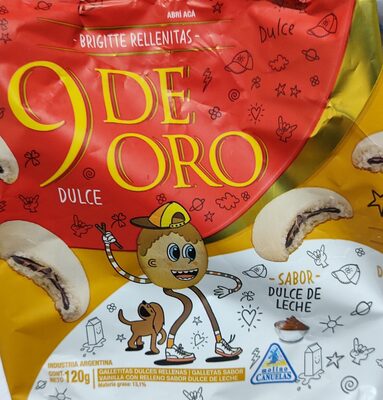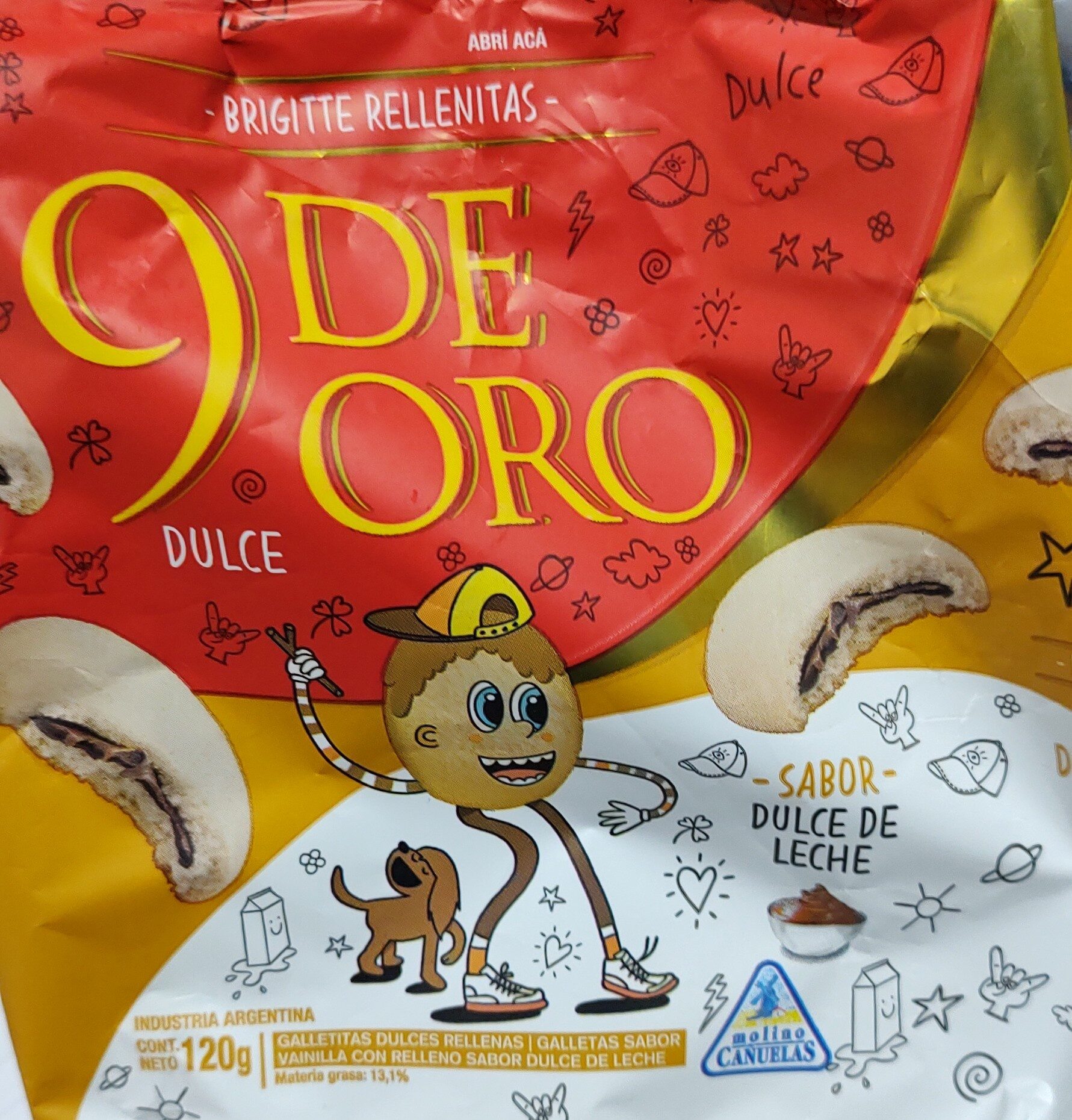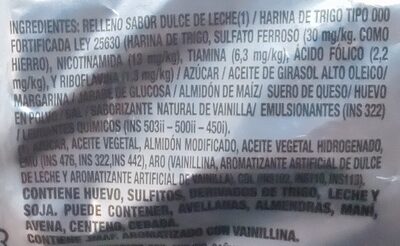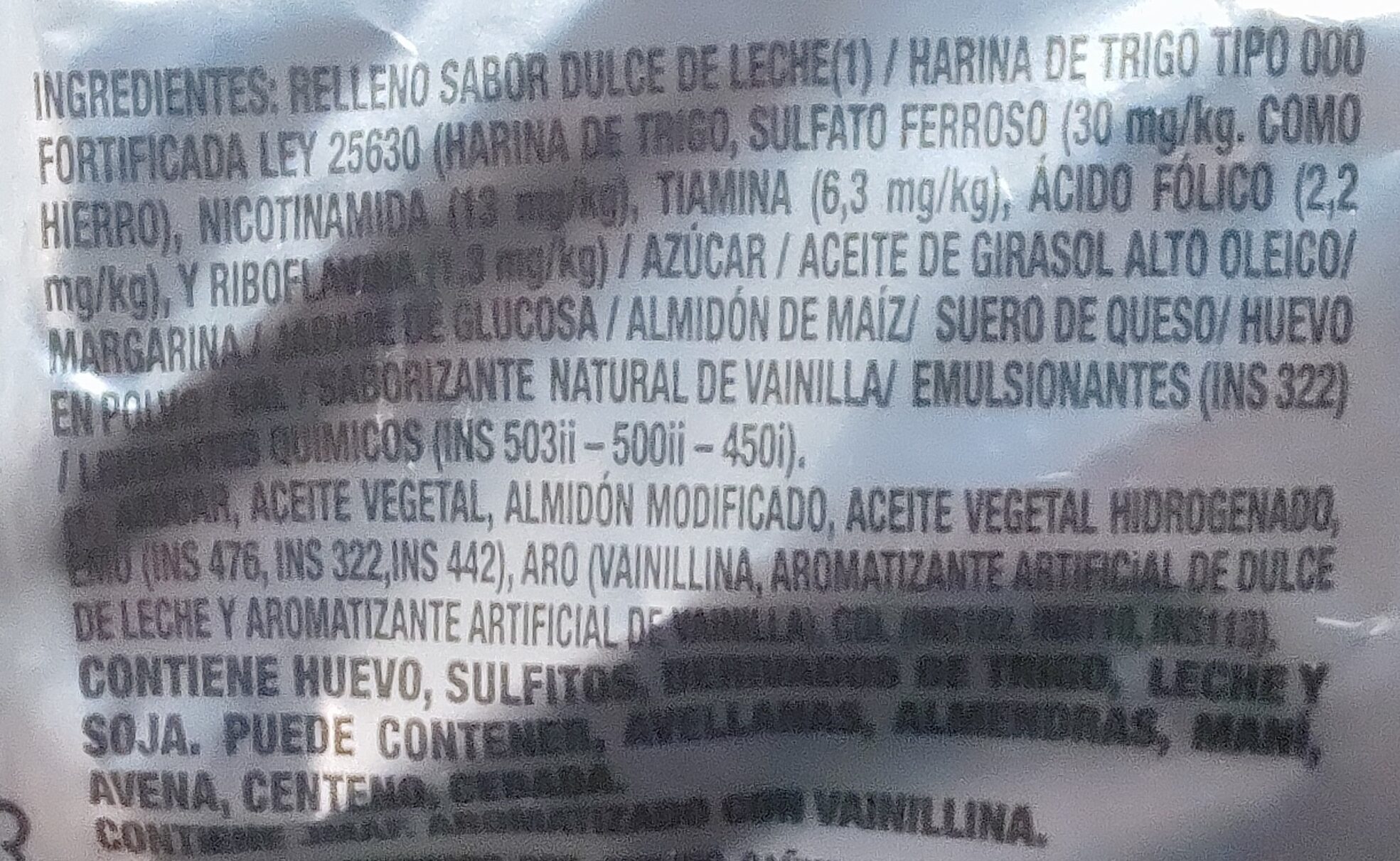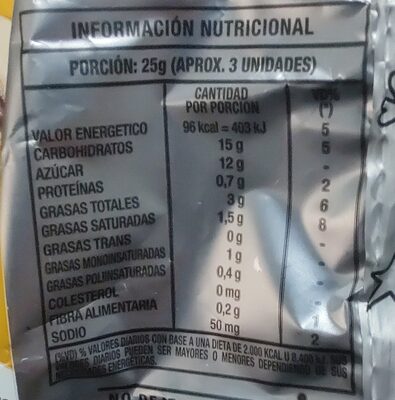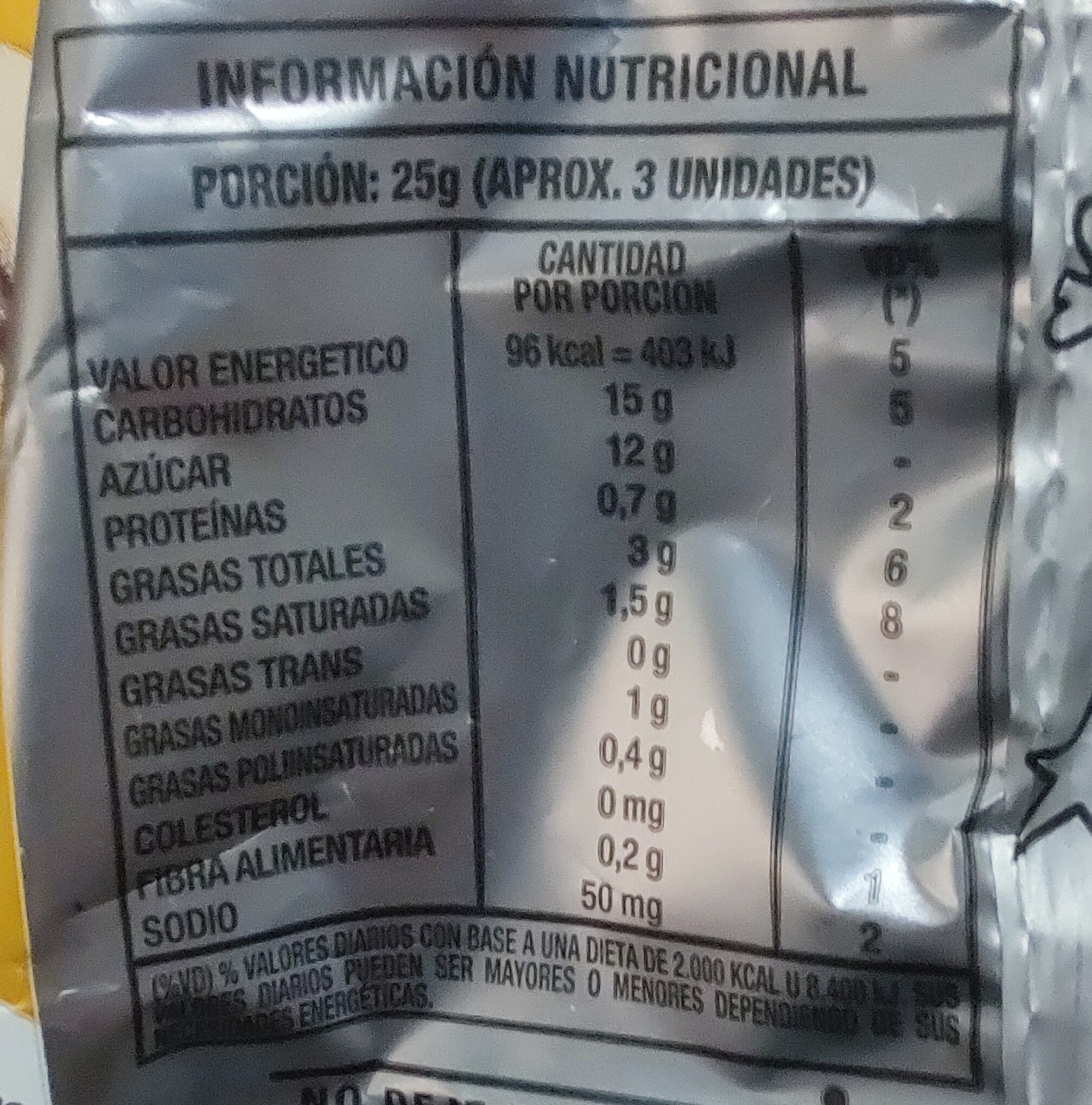Help us make food transparency the norm!
As a non-profit organization, we depend on your donations to continue informing consumers around the world about what they eat.
The food revolution starts with you!
Brigitte Rellenitas sabor Dulce de Leche - 120 g
Brigitte Rellenitas sabor Dulce de Leche - 120 g
This product page is not complete. You can help to complete it by editing it and adding more data from the photos we have, or by taking more photos using the app for Android or iPhone/iPad. Thank you!
×
Barcode: 7792180139993 (EAN / EAN-13)
Common name: galletas sabor vainilla con relleno sabor dulce de leche
Quantity: 120 g
Packaging: Plastic, Bag, Pouch flask
Brands: Brigitte, 9 de Oro, Molino Cañuelas
Categories: Snacks, Sweet snacks, Biscuits and cakes, Biscuits, Filled biscuits
Origin of ingredients: Argentina
Manufacturing or processing places: Argentina
Traceability code: RNE 02-034921
Countries where sold: Argentina, Bolivia, Paraguay, United States
Matching with your preferences
Health
Ingredients
-
39 ingredients
: Relleno sabor dulce de leche (azúcar, aceite vegetal, almidón modificado, aceite vegetal hidrogenado, emulsionantes (INS 476, INS 322, INS 442), aromatizante (vainillina, aroma artificial de dulce de leche, aroma artificial de vainilla), colorantes (INS 102, INS 110, INS 113)), harina de trigo tipo 000 (harina de trigo, sulfato ferroso 0.003%, nicotinamida 0.0013%, tiamina 0.00063%, ácido fólico 0.00022 %, riboflavina 0.00013 %), azúcar, aceite de girasol alto oleico, margarina, jarabe de glucosa, almidón de maíz, suero de queso, huevo en polvo, sal, saborizante natural de vainilla, emulsionantes (INS 322), leudantes químicos (INS 503ii, INS 500ii, INS 450i).Allergens: Eggs, Gluten, Milk, Soybeans, Sulphur dioxide and sulphitesTraces: Gluten, Nuts, Peanuts
Food processing
-
Ultra processed foods
Elements that indicate the product is in the 4 - Ultra processed food and drink products group:
- Additive: E102 - Tartrazine
- Additive: E110 - Sunset yellow FCF
- Additive: E14XX - Modified Starch
- Additive: E322 - Lecithins
- Additive: E442 - Ammonium phosphatides
- Additive: E450 - Diphosphates
- Additive: E476 - Polyglycerol polyricinoleate
- Ingredient: Colour
- Ingredient: Emulsifier
- Ingredient: Flavouring
- Ingredient: Glucose
- Ingredient: Glucose syrup
- Ingredient: Hydrogenated oil
Food products are classified into 4 groups according to their degree of processing:
- Unprocessed or minimally processed foods
- Processed culinary ingredients
- Processed foods
- Ultra processed foods
The determination of the group is based on the category of the product and on the ingredients it contains.
Additives
-
E102 - Tartrazine
Tartrazine: Tartrazine is a synthetic lemon yellow azo dye primarily used as a food coloring. It is also known as E number E102, C.I. 19140, FD&C Yellow 5, Acid Yellow 23, Food Yellow 4, and trisodium 1--4-sulfonatophenyl--4--4-sulfonatophenylazo--5-pyrazolone-3-carboxylate-.Tartrazine is a commonly used color all over the world, mainly for yellow, and can also be used with Brilliant Blue FCF -FD&C Blue 1, E133- or Green S -E142- to produce various green shades.Source: Wikipedia
-
E110 - Sunset yellow FCF
Sunset Yellow FCF: Sunset Yellow FCF -also known as Orange Yellow S, or C.I. 15985- is a petroleum-derived orange azo dye with a pH dependent maximum absorption at about 480 nm at pH 1 and 443 nm at pH 13 with a shoulder at 500 nm. When added to foods sold in the US it is known as FD&C Yellow 6; when sold in Europe, it is denoted by E Number E110.Source: Wikipedia
-
E322 - Lecithins
Lecithins are natural compounds commonly used in the food industry as emulsifiers and stabilizers.
Extracted from sources like soybeans and eggs, lecithins consist of phospholipids that enhance the mixing of oil and water, ensuring smooth textures in various products like chocolates, dressings, and baked goods.
They do not present any known health risks.
-
E442 - Ammonium phosphatides
Mixed ammonium salts of phosphorylated glycerides: The mix of ammonium salts of phosphorylated glycerides can be either made synthetically or from mixture of glycerol and partially hardened plant -most often used: rapeseed oil- oils.Source: Wikipedia
-
E450 - Diphosphates
Diphosphates (E450) are food additives often utilized to modify the texture of products, acting as leavening agents in baking and preventing the coagulation of canned food.
These salts can stabilize whipped cream and are also found in powdered products to maintain their flow properties. They are commonly present in baked goods, processed meats, and soft drinks.
Derived from phosphoric acid, they're part of our daily phosphate intake, which often surpasses recommended levels due to the prevalence of phosphates in processed foods and drinks.
Excessive phosphate consumption is linked to health issues, such as impaired kidney function and weakened bone health. Though diphosphates are generally regarded as safe when consumed within established acceptable daily intakes, it's imperative to monitor overall phosphate consumption to maintain optimal health.
-
E476 - Polyglycerol polyricinoleate
Polyglycerol polyricinoleate: Polyglycerol polyricinoleate -PGPR-, E476, is an emulsifier made from glycerol and fatty acids -usually from castor bean, but also from soybean oil-. In chocolate, compound chocolate and similar coatings, PGPR is mainly used with another substance like lecithin to reduce viscosity. It is used at low levels -below 0.5%-, and works by decreasing the friction between the solid particles -e.g. cacao, sugar, milk- in molten chocolate, reducing the yield stress so that it flows more easily, approaching the behaviour of a Newtonian fluid. It can also be used as an emulsifier in spreads and in salad dressings, or to improve the texture of baked goods. It is made up of a short chain of glycerol molecules connected by ether bonds, with ricinoleic acid side chains connected by ester bonds. PGPR is a yellowish, viscous liquid, and is strongly lipophilic: it is soluble in fats and oils and insoluble in water and ethanol.Source: Wikipedia
-
E500 - Sodium carbonates
Sodium carbonates (E500) are compounds commonly used in food preparation as leavening agents, helping baked goods rise by releasing carbon dioxide when they interact with acids.
Often found in baking soda, they regulate the pH of food, preventing it from becoming too acidic or too alkaline. In the culinary world, sodium carbonates can also enhance the texture and structure of foods, such as noodles, by modifying the gluten network.
Generally recognized as safe, sodium carbonates are non-toxic when consumed in typical amounts found in food.
-
E500ii - Sodium hydrogen carbonate
Sodium hydrogen carbonate, also known as E500ii, is a food additive commonly used as a leavening agent.
When added to recipes, it releases carbon dioxide gas upon exposure to heat or acids, causing dough to rise and resulting in a light, fluffy texture in baked goods.
It is generally recognized as safe (GRAS) by regulatory authorities when used in appropriate quantities and poses no significant health risks when consumed in typical food applications.
-
E503 - Ammonium carbonates
Ammonium carbonate: Ammonium carbonate is a salt with the chemical formula -NH4-2CO3. Since it readily degrades to gaseous ammonia and carbon dioxide upon heating, it is used as a leavening agent and also as smelling salt. It is also known as baker's ammonia and was a predecessor to the more modern leavening agents baking soda and baking powder. It is a component of what was formerly known as sal volatile and salt of hartshorn.Source: Wikipedia
-
E503ii - Ammonium hydrogen carbonate
Ammonium carbonate: Ammonium carbonate is a salt with the chemical formula -NH4-2CO3. Since it readily degrades to gaseous ammonia and carbon dioxide upon heating, it is used as a leavening agent and also as smelling salt. It is also known as baker's ammonia and was a predecessor to the more modern leavening agents baking soda and baking powder. It is a component of what was formerly known as sal volatile and salt of hartshorn.Source: Wikipedia
Ingredients analysis
-
May contain palm oil
Ingredients that may contain palm oil: Vegetable oil, Hydrogenated vegetable oil
-
Non-vegan
Non-vegan ingredients: Egg powderSome ingredients could not be recognized.
We need your help!
You can help us recognize more ingredients and better analyze the list of ingredients for this product and others:
- Edit this product page to correct spelling mistakes in the ingredients list, and/or to remove ingredients in other languages and sentences that are not related to the ingredients.
- Add new entries, synonyms or translations to our multilingual lists of ingredients, ingredient processing methods, and labels.
If you would like to help, join the #ingredients channel on our Slack discussion space and/or learn about ingredients analysis on our wiki. Thank you!
-
Vegetarian status unknown
Unrecognized ingredients: es:relleno-sabor-dulce-de-leche, Vanillin, es:aroma-artificial-de-dulce-de-leche, es:aroma-artificial-de-vainilla, es:e113, es:harina-de-trigo-tipo-000, Ferrous sulfate, Thiamin, Folic acid, Margarine, es:suero-de-quesoSome ingredients could not be recognized.
We need your help!
You can help us recognize more ingredients and better analyze the list of ingredients for this product and others:
- Edit this product page to correct spelling mistakes in the ingredients list, and/or to remove ingredients in other languages and sentences that are not related to the ingredients.
- Add new entries, synonyms or translations to our multilingual lists of ingredients, ingredient processing methods, and labels.
If you would like to help, join the #ingredients channel on our Slack discussion space and/or learn about ingredients analysis on our wiki. Thank you!
-
Details of the analysis of the ingredients
We need your help!
Some ingredients could not be recognized.
We need your help!
You can help us recognize more ingredients and better analyze the list of ingredients for this product and others:
- Edit this product page to correct spelling mistakes in the ingredients list, and/or to remove ingredients in other languages and sentences that are not related to the ingredients.
- Add new entries, synonyms or translations to our multilingual lists of ingredients, ingredient processing methods, and labels.
If you would like to help, join the #ingredients channel on our Slack discussion space and/or learn about ingredients analysis on our wiki. Thank you!
: Relleno sabor dulce de leche (azúcar, aceite vegetal, almidón modificado, aceite vegetal hidrogenado, emulsionantes (e476, e322, e442), aromatizante (vainillina, aroma artificial de dulce de leche, aroma artificial de vainilla), colorantes (e102, e110, e113)), harina de trigo tipo 000 (harina de trigo, sulfato ferroso 0.003%, nicotinamida 0.0013%, tiamina 0.00063%, ácido fólico 0.00022%, riboflavina 0.00013%), azúcar, aceite de girasol alto oleico, margarina, jarabe de glucosa, almidón de maíz, suero de queso, huevo en polvo, sal, saborizante natural de vainilla, emulsionantes (e322), leudantes químicos (e503ii, e500ii, e450i)- Relleno sabor dulce de leche -> es:relleno-sabor-dulce-de-leche - percent_min: 7.69230769230769 - percent_max: 100
- azúcar -> en:sugar - vegan: yes - vegetarian: yes - ciqual_proxy_food_code: 31016 - percent_min: 1.0989010989011 - percent_max: 100
- aceite vegetal -> en:vegetable-oil - vegan: yes - vegetarian: yes - from_palm_oil: maybe - percent_min: 0 - percent_max: 50
- almidón modificado -> en:modified-starch - vegan: yes - vegetarian: yes - ciqual_proxy_food_code: 9510 - percent_min: 0 - percent_max: 33.3333333333333
- aceite vegetal hidrogenado -> en:hydrogenated-vegetable-oil - vegan: yes - vegetarian: yes - from_palm_oil: maybe - percent_min: 0 - percent_max: 25
- emulsionantes -> en:emulsifier - percent_min: 0 - percent_max: 20
- e476 -> en:e476 - vegan: yes - vegetarian: yes - percent_min: 0 - percent_max: 20
- e322 -> en:e322 - vegan: maybe - vegetarian: maybe - percent_min: 0 - percent_max: 10
- e442 -> en:e442 - vegan: maybe - vegetarian: maybe - percent_min: 0 - percent_max: 6.66666666666667
- aromatizante -> en:flavouring - vegan: maybe - vegetarian: maybe - percent_min: 0 - percent_max: 5
- vainillina -> en:vanillin - percent_min: 0 - percent_max: 5
- aroma artificial de dulce de leche -> es:aroma-artificial-de-dulce-de-leche - percent_min: 0 - percent_max: 2.5
- aroma artificial de vainilla -> es:aroma-artificial-de-vainilla - percent_min: 0 - percent_max: 1.66666666666667
- colorantes -> en:colour - percent_min: 0 - percent_max: 5
- e102 -> en:e102 - vegan: yes - vegetarian: yes - percent_min: 0 - percent_max: 5
- e110 -> en:e110 - vegan: yes - vegetarian: yes - percent_min: 0 - percent_max: 2.5
- e113 -> es:e113 - percent_min: 0 - percent_max: 1.66666666666667
- harina de trigo tipo 000 -> es:harina-de-trigo-tipo-000 - percent_min: 0 - percent_max: 50
- harina de trigo -> en:wheat-flour - vegan: yes - vegetarian: yes - ciqual_proxy_food_code: 9410 - percent_min: 0.003 - percent_max: 49.99472
- sulfato ferroso -> en:ferrous-sulfate - percent_min: 0.003 - percent: 0.003 - percent_max: 0.003
- nicotinamida -> en:e375 - vegan: maybe - vegetarian: maybe - percent_min: 0.0013 - percent: 0.0013 - percent_max: 0.0013
- tiamina -> en:thiamin - percent_min: 0.00063 - percent: 0.00063 - percent_max: 0.00063
- ácido fólico -> en:folic-acid - percent_min: 0.00022 - percent: 0.00022 - percent_max: 0.00022
- riboflavina -> en:e101 - vegan: maybe - vegetarian: yes - percent_min: 0.00013 - percent: 0.00013 - percent_max: 0.00013
- azúcar -> en:sugar - vegan: yes - vegetarian: yes - ciqual_proxy_food_code: 31016 - percent_min: 0 - percent_max: 33.3333333333333
- aceite de girasol alto oleico -> en:high-oleic-sunflower-oil - vegan: yes - vegetarian: yes - from_palm_oil: no - ciqual_food_code: 17440 - percent_min: 0 - percent_max: 25
- margarina -> en:margarine - percent_min: 0 - percent_max: 20
- jarabe de glucosa -> en:glucose-syrup - vegan: yes - vegetarian: yes - ciqual_proxy_food_code: 31016 - percent_min: 0 - percent_max: 16.6666666666667
- almidón de maíz -> en:corn-starch - vegan: yes - vegetarian: yes - ciqual_food_code: 9510 - percent_min: 0 - percent_max: 14.2857142857143
- suero de queso -> es:suero-de-queso - percent_min: 0 - percent_max: 12.5
- huevo en polvo -> en:egg-powder - vegan: no - vegetarian: yes - ciqual_food_code: 22000 - percent_min: 0 - percent_max: 11.1111111111111
- sal -> en:salt - vegan: yes - vegetarian: yes - ciqual_food_code: 11058 - percent_min: 0 - percent_max: 0.5
- saborizante natural de vainilla -> en:natural-vanilla-flavouring - vegan: yes - vegetarian: yes - percent_min: 0 - percent_max: 0.5
- emulsionantes -> en:emulsifier - percent_min: 0 - percent_max: 0.5
- e322 -> en:e322 - vegan: maybe - vegetarian: maybe - percent_min: 0 - percent_max: 0.5
- leudantes químicos -> en:raising-agent - percent_min: 0 - percent_max: 0.5
- e503ii -> en:e503ii - vegan: yes - vegetarian: yes - percent_min: 0 - percent_max: 0.5
- e500ii -> en:e500ii - vegan: yes - vegetarian: yes - percent_min: 0 - percent_max: 0.25
- e450i -> en:e450i - vegan: yes - vegetarian: yes - percent_min: 0 - percent_max: 0.166666666666667
Nutrition
-
Bad nutritional quality
⚠ ️Warning: the amount of fruits, vegetables and nuts is not specified on the label, it was estimated from the list of ingredients: 0This product is not considered a beverage for the calculation of the Nutri-Score.
Positive points: 0
- Proteins: 1 / 5 (value: 2.8, rounded value: 2.8)
- Fiber: 0 / 5 (value: 0.8, rounded value: 0.8)
- Fruits, vegetables, nuts, and colza/walnut/olive oils: 0 / 5 (value: 0, rounded value: 0)
Negative points: 21
- Energy: 4 / 10 (value: 1610, rounded value: 1610)
- Sugars: 10 / 10 (value: 48, rounded value: 48)
- Saturated fat: 5 / 10 (value: 6, rounded value: 6)
- Sodium: 2 / 10 (value: 200, rounded value: 200)
The points for proteins are not counted because the negative points are greater or equal to 11.
Nutritional score: (21 - 0)
Nutri-Score:
-
Nutrient levels
-
Fat in moderate quantity (12%)
What you need to know- A high consumption of fat, especially saturated fats, can raise cholesterol, which increases the risk of heart diseases.
Recommendation: Limit the consumption of fat and saturated fat- Choose products with lower fat and saturated fat content.
-
Saturated fat in high quantity (6%)
What you need to know- A high consumption of fat, especially saturated fats, can raise cholesterol, which increases the risk of heart diseases.
Recommendation: Limit the consumption of fat and saturated fat- Choose products with lower fat and saturated fat content.
-
Sugars in high quantity (48%)
What you need to know- A high consumption of sugar can cause weight gain and tooth decay. It also augments the risk of type 2 diabetes and cardio-vascular diseases.
Recommendation: Limit the consumption of sugar and sugary drinks- Sugary drinks (such as sodas, fruit beverages, and fruit juices and nectars) should be limited as much as possible (no more than 1 glass a day).
- Choose products with lower sugar content and reduce the consumption of products with added sugars.
-
Salt in moderate quantity (0.5%)
What you need to know- A high consumption of salt (or sodium) can cause raised blood pressure, which can increase the risk of heart disease and stroke.
- Many people who have high blood pressure do not know it, as there are often no symptoms.
- Most people consume too much salt (on average 9 to 12 grams per day), around twice the recommended maximum level of intake.
Recommendation: Limit the consumption of salt and salted food- Reduce the quantity of salt used when cooking, and don't salt again at the table.
- Limit the consumption of salty snacks and choose products with lower salt content.
-
-
Nutrition facts
Nutrition facts As sold
for 100 g / 100 mlAs sold
per serving (25 g)Compared to: Filled biscuits Energy 1,610 kj
(384 kcal)403 kj
(96 kcal)-18% Fat 12 g 3 g -41% Saturated fat 6 g 1.5 g -19% Monounsaturated fat 4 g 1 g Polyunsaturated fat 1.6 g 0.4 g Trans fat 0 g 0 g Cholesterol 0 mg 0 mg -100% Salt 0.5 g 0.125 g -35% Carbohydrates 60 g 15 g -11% Fiber 0.8 g 0.2 g -63% Sugars 48 g 12 g +28% Proteins 2.8 g 0.7 g -33% Fruits‚ vegetables‚ nuts and rapeseed‚ walnut and olive oils (estimate from ingredients list analysis) 0 % 0 %
Environment
-
Eco-Score C - Moderate environmental impact
The Eco-Score is an experimental score that summarizes the environmental impacts of food products.→ The Eco-Score was initially developped for France and it is being extended to other European countries. The Eco-Score formula is subject to change as it is regularly improved to make it more precise and better suited to each country.Life cycle analysis
-
Average impact of products of the same category: B (Score: 69/100)
Category: Biscuit (cookie)
Category: Biscuit (cookie)
- PEF environmental score: 0.35 (the lower the score, the lower the impact)
- including impact on climate change: 2.88 kg CO2 eq/kg of product
Stage Impact Agriculture
80.5 %Processing
11.8 %Packaging
3.1 %Transportation
3.2 %Distribution
1.4 %Consumption
0.0 %
Bonuses and maluses
-
Origins of ingredients with a high impact
Malus: -3
Environmental policy: -3
Transportation: 0
Origin of the product and/or its ingredients % of ingredients Impact Argentina 100 %High
-
Packaging with a high impact
Malus: -15
Shape Material Recycling Impact Pouch flask Plastic High Bag Unknown High ⚠ ️ The information about the packaging of this product is not sufficiently precise (exact shapes and materials of all components of the packaging).⚠ ️ For a more precise calculation of the Eco-Score, you can modify the product page and add them.
If you are the manufacturer of this product, you can send us the information with our free platform for producers.
Eco-Score for this product
-
Impact for this product: C (Score: 51/100)
Product: Brigitte Rellenitas sabor Dulce de Leche - 120 g
Life cycle analysis score: 69
Sum of bonuses and maluses: -18
Final score: 51/100
-
Carbon footprint
-
Equal to driving 1.5 km in a petrol car
288 g CO² per 100g of product
The carbon emission figure comes from ADEME's Agribalyse database, for the category: Biscuit (cookie) (Source: ADEME Agribalyse Database)
Stage Impact Agriculture
82.9 %Processing
7.9 %Packaging
3.8 %Transportation
4.7 %Distribution
0.7 %Consumption
0.0 %
Packaging
-
Packaging with a high impact
-
Packaging parts
Pouch flask (Plastic)
Bag
-
Packaging materials
Material % Packaging weight Packaging weight per 100 g of product Plastic
-
Transportation
-
Origins of ingredients
Origins of ingredients with a high impact
Origin of the product and/or its ingredients % of ingredients Impact Argentina 100 %High
Report a problem
-
Incomplete or incorrect information?
Category, labels, ingredients, allergens, nutritional information, photos etc.
If the information does not match the information on the packaging, please complete or correct it. Open Food Facts is a collaborative database, and every contribution is useful for all.
